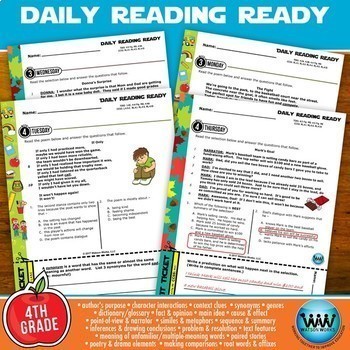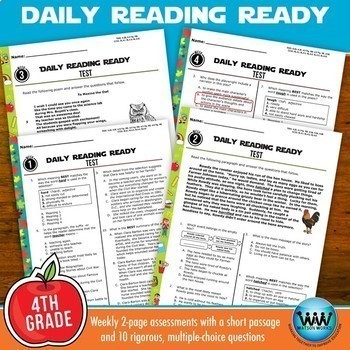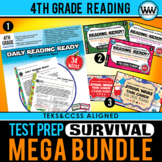BUNDLE 4th Grade Daily Reading Spiral Review Full Year New ELAR TEKS
- Zip
What educators are saying
Products in this Bundle (9)
showing 1-5 of 9 products
Also included in
- All your favorite resources in one MEGA BUNDLE! Just what you need to make it through the big test with ease and confidence! SAVE 30% WHEN PURCHASING THIS MEGA BUNDLE compared to purchasing individual sets! Included:1) 34 Weeks of Daily Spiral Review for 4th Grade2) Differentiated Skill-Based 4th GPrice $106.10Original Price $151.57Save $45.47
Description
With the implementation of the new ELAR TEKS this year, having a daily spiral review in your toolbox that reviews all the readiness and supporting TEKS for reading is a MUST!! DAILY READING READY© is a standards-based program that follows a research-based model of continuous, systematic instruction, building from simple to complex to help students learn and retain skills. The full 4th grade bundle includes 34 weeks of daily lessons & weekly assessments.
**SAVE 20% on this FULL-YEAR BUNDLE!! Includes 9 months of 4th grade daily reading & vocabulary lessons and weekly assessments for August/September – May/June!**
How it Works:
Monday – Thursday, students will read a brief passage and:
- answer 2 rigorous, multiple-choice questions
- complete 1 exit ticket (a short, 1-2 minute formative assessment linked to the objective of that day’s lessons)
On Friday, students will read a short passage and complete a brief, 2-page formal assessment with 10 rigorous, multiple-choice questions that measure their understanding of the skills taught during the week. *A list of key terms is also included for teacher reference, or to send home with students to review with parents before the weekly assessments.
The program is designed so that all 4th grade reading TEKS are covered and reviewed before the STAAR Reading Test; the daily lessons & assessments after the STAAR test will continue to review the 4th grade reading skills until the end of the school year.
*If you purchased this bundle while it was a “growing bundle,” go to your “My Purchases” folder on TpT and re-download the bundle to access all of the monthly units.*
**Though this DAILY READING READY© unit was made with our Texas teacher friends in mind, it is also aligned with 4th grade CCSS, making it easily usable by any 4th grade teacher teaching reading all over the U.S.**
***Suggested use with our READING READY Task Cards©. ***
******************************************************************************
These are the units included in this full-year bundle:
•August/September – 4 weeks of daily lessons & weekly assessments that address:
- author’s purpose & craft
- character interactions
- context clues
- dictionary/glossary
- genre – fiction & poetry
- images/words/graphics/sounds to impact meaning
- making inferences & drawing conclusions
- main idea & key details
- meaning of unfamiliar/multiple-meaning words
- poetry elements
- point-of-view & narrator
- problem & resolution
- root words & affixes
- sequence & summary
- similes & metaphors
- synonyms
- theme/lesson/main message
Standards Covered:
- 2019 TEKS: 3.3D, 4.3A, 4.3B, 4.3C, 4.6D, 4.6F, 4.6G, 4.7D, 4.8A, 4.8B, 4.8C, 4.9A, 4.9B, 4.10A, 4.10B, 4.10C, 4.10D, 4.10E
- CCSS: L.4.4.B, L.4.4.C, L.4.5, L.4.5.A, L.4.5.C, RL.3.2, RL.3.7, RL.4.1, RL.4.2, RL.4.3, RL.4.4, RL.4.5, RL.4.6, RL.4.10
•October – 4 weeks of daily lessons & weekly assessments that address:
- author’s purpose & craft
- author’s use of language
- context clues
- dictionary/glossary
- drama structural elements
- generating questions
- genre – literary nonfiction, biography, autobiography, & drama
- images/words/graphics/sounds to impact meaning
- making inferences & drawing conclusions
- making predictions
- meaning of unfamiliar/multiple-meaning words
- point-of-view & narrator
- root words & affixes
- sequence & summary
- supporting understanding with textual evidence
- synonyms
- theme/lesson/main message
Standards Covered:
- 2019 TEKS: 3.3D, 4.3A, 4.3B, 4.3C, 4.6C, 4.6F, 4.7C, 4.7D, 4.8A, 4.9C, 4.10A, 4.10C, 4.10D, 4.10E
- CCSS: L.4.4.B, L.4.4.C, L.4.5.C, RI.3.1, RI.4.1, RI.4.2, RI.4.4, RI.4.7, RI.4.8, RI.4.10, RL.4.1, RL.4.2, RL.4.5, RL.4.6, RL.4.10
•November – 3 weeks of daily lessons & weekly assessments that address:
- author’s purpose & craft
- author’s use of language
- cause & effect
- central idea
- context clues
- dictionary/glossary
- evaluating details to determine key ideas
- generating questions to deepen understanding/gain information
- genre – informational, expository
- images/words/graphics/sounds to impact meaning
- making inferences & drawing conclusions
- meaning of unfamiliar/multiple-meaning words
- root words & affixes
- sequence & summary
- supporting understanding with textual evidence
- synonyms
- text organization/structure
Standards Covered:
- 2019 TEKS: 3.3D, 4.3A, 4.3B, 4.3C, 4.6B, 4.6F, 4.6G, 4.7D, 4.9Di, 4.9Diii, 4.10A, 4.10C, 4.10D
- CCSS: L.4.4.B, L.4.4.C, L.4.5.C, RI.3.1, RI.4.1, RI.4.2, RI.4.4, RI.4.5, RI.4.7, RI.4.8, RI.4.10
•December – 3 weeks of daily lessons & weekly assessments that address:
- author’s purpose & craft
- author’s use of language
- cause & effect
- central idea & supporting evidence
- context clues
- dictionary/glossary
- evaluating details to determine key ideas
- genre – informational, expository
- images/words/graphics/sounds to impact meaning
- making inferences & drawing conclusions
- meaning of unfamiliar/multiple-meaning words
- print/graphic features
- root words & affixes
- sequence & summary
- supporting understanding with textual evidence
- synonyms
- text structure & organization
Standards Covered:
- •2019 TEKS: 3.3D, 4.3A, 4.3B, 4.3C, 4.6F, 4.6G, 4.7D, 4.9B, 4.9Di, 4.9Diii, 4.10A, 4.10C, 4.10D
- •CCSS: L.4.4.B, L.4.4.C, L.4.5.A, L.4.5.C, RI.4.1, RI.4.2, RI.4.4, RI.4.5, RI.4.7, RI.4.8, RI.4.10
•January – 4 weeks of daily lessons & weekly assessments that address:
- author’s purpose & craft
- author’s use of language
- central idea & supporting evidence
- character interactions
- compare & contrast
- context clues
- drama & poetry elements
- figurative language
- generating questions to deepen understanding/gain information
- genre – expository, fiction, drama, poetry, advertisements
- images/words/graphics/sounds to impact meaning
- making connections between literary & informational texts
- making inferences & drawing conclusions
- meaning of unfamiliar/multiple-meaning words
- paired passages
- point-of-view & narrator
- print/graphic features
- problem & resolution
- root words & affixes
- sequence & summary
- supporting understanding with textual evidence
- synonyms
- synthesizing information to create new understanding
Standards Covered:
- 2019 TEKS: 3.3D, 4.3B, 4.3C, 4.6B, 4.6E, 4.6F, 4.6H, 4.7D, 4.8B, 4.8C, 4.9B, 4.9Di, 4.9Dii, 4.10A, 4.10C, 4.10D, 4.10E
- CCSS: L.4.4.B, L.4.5.A, L.4.5.C, RI.3.1, RI.4.1, RI.4.2, RI.4.4, RI.4.6, RI.4.7, RI.4.8, RI.4.9, RI.4.10, RL.3.7, RL.4.1, RL.4.3, RL.4.4, RL.4.6, RL.4.10
•February – 4 weeks of daily lessons & weekly assessments that address:
- author’s purpose & craft
- author’s use of language
- cause & effect
- central idea & supporting evidence
- character interactions/changes
- compare & contrast
- context clues
- dictionary & glossary
- figurative language
- generating questions to deepen understanding/gain information
- genre – expository/informational, fiction, literary nonfiction, poetry, procedural
- graphic features of text
- images/words/graphics/sounds to impact meaning
- informational text features
- making connections between literary & informational texts
- making inferences & drawing conclusions
- meaning of unfamiliar/multiple-meaning words
- paired passages
- plot
- poetry elements
- print/graphic features
- problem & resolution
- root words & affixes
- sequence & summary
- supporting understanding with textual evidence
- synonyms
- text structure/organization
Standards Covered:
- 2019 TEKS: 4.3A, 4.3B, 4.3C, 4.6B, 4.6E, 4.6F, 4.7D, 4.8A, 4.8B, 4.8C, 4.9Di, 4.9Dii, 4.9Diii, 4.10A, 4.10B, 4.10C, 4.10D
- CCSS: L.4.4.B, L.4.4.C, L.4.5.C, RI.3.1, RI.4.1, RI.4.2, RI.4.4, RI.4.5, RI.4.6, RI.4.7, RI.4.8, RI.4.10, RL.4.1, RL.4.2, RL.4.3, RL.4.4, RL.4.5, RL.4.6, RL.4.7, RL.4.10
•March – 4 weeks of daily lessons & weekly assessments that address:
- author’s purpose & craft
- author’s use of language
- cause & effect
- central idea & supporting evidence
- character interactions/changes
- compare & contrast
- context clues
- dictionary & glossary
- drama elements
- figurative language
- genre – expository/informational, fiction, literary nonfiction, drama, advertisements
- images/words/graphics/sounds to impact meaning
- making connections between literary & informational texts
- making inferences & drawing conclusions
- making predictions
- meaning of unfamiliar/multiple-meaning words
- paired passages
- plot
- point-of-view & narrator
- print/graphic features
- root words & affixes
- sequence & summary
- supporting understanding with textual evidence
- synonyms
- text structure/organization
- theme
Standards Covered:
- 2019 TEKS: 3.3D, 4.3A, 4.3B, 4.3C, 4.6C, 4.6E, 4.6F, 4.7D, 4.8A, 4.8B, 4.8C, 4.9B, 4.9C, 4.9Di, 4.9Diii, 4.10A, 4.10B, 4.10C, 4.10D, 4.10E
- CCSS: L.4.4.B, L.4.4.C, L.4.5.A, L.4.5.C, RI.4.1, RI.4.2, RI.4.4, RI.4.5, RI.4.6, RI.4.7, RI.4.10, RL.4.1, RL.4.2, RL.4.3, RL.4.4, RL.4.5. RL.4.6, RL.4.10
•April – 4 weeks of daily lessons & weekly assessments that address:
-author’s purpose & craft
-compare & contrast
-context clues
-dictionary & glossary
-drama & poetry elements
-fact & opinion
-genre –expository, fiction, literary nonfiction, drama, poetry
-graphic features of texts
-images/words/graphics/sounds to impact meaning
-main idea & supporting details
-making connections between literary & informational texts
-making inferences & drawing conclusions
-meaning of unfamiliar/multiple-meaning words
-paired passages
-point-of-view
-root words & affixes
-sequence & summary
-supporting understanding with textual evidence
-synonyms
Standards Covered:
TEKS: 3.4C, 4.2A, 4.2B, 4.2E, 4.3 Fig. 19D, 4.4 Fig. 19D, 4.4A, 4.5 Fig. 19D, 4.5A, 4.6 Fig. 19D, 4.6B, 4.6C, 4.7 Fig. 19D, 4.10 Fig. 19D, 4.10A, 4.11 Fig. 19D, 4.11A, 4.11B, 4.11C, 4.11D, 4.14 Fig. 19D, 4 Fig. 19F
CCSS: L.4.4.B, L.4.5.C, RI.4.1, RI.4.2, RI.4.3, RI.4.4, RI.4.5, RI.4.6, RI.4.7, RI.4.8, RI.4.10, RL.4.1, RL.4.2, RL.4.3, RL.4.4, RL.4.5, RL.4.6, RL.4.8, RL.4.10
•May/June – 4 weeks of daily lessons & weekly assessments that address:
-author’s purpose & craft
-cause & effect
-character interactions
-compare & contrast
-context clues
-fact & opinion
-genre – expository, fiction, literary nonfiction, poetry
-graphic features of text
-images/words/graphics/sounds to impact meaning
-main idea & supporting details
-making connections between literary & informational texts
-making inferences & drawing conclusions
-meaning of unfamiliar/multiple-meaning words
-paired passages
-poetry elements
-root words & affixes
-sequence & summary
-supporting understanding with textual evidence
-synonyms
-text features
Standards Covered:
TEKS: 3.4C, 4.2A, 4.2B, 4.3 Fig. 19D, 4.4 Fig. 19D, 4.4A, 4.6 Fig. 19D, 4.6A, 4.6B, 4.7 Fig. 19D, 4.10 Fig. 19D, 4.10 Fig. 19D, 4.11 Fig. 19E, 4.11A, 4.11B, 4.11C, 4.11D, 4.14 Fig. 19D, 4 Fig. 19F
CCSS: L.4.4.B, L.4.5.C, RI.4.1, RI.4.2, RI.4.4, RI.4.5, RI.4.6, RI.4.7, RI.4.8, RI.4.10, RL.4.1, RL.4.2, RL.4.3, RL.4.4, RL.4.5, RL.4.10
We hope you like these units as much as we do, and we’d love to hear your feedback! :)
~Heather & Ashley
Watson Works, LLC
*Full preview of the units included in the product available by selecting the preview button above.
Follow us on TpT, Facebook, Instagram and/or Pinterest to be alerted when new products are added. Any time we add a new product, we offer it for 50% off for the first 24 hours after it is uploaded. Click the “Follow Me” button above to receive email notifications from TpT so that you can save!
Terms of Use:
© 2017, 2018 Watson Works, LLC. Except as permitted under the United States Copyright Act, no part of this publication may be reproduced, stored, or distributed in any form or by any means (mechanically, electronically, recording, etc.) without the prior written consent of Watson Works, LLC. Purchasing this product in digital form from the Watson Works store on TeachersPayTeachers.com licenses one teacher to use this product in his/her classroom or for personal use. Additional licenses must be purchased for additional teachers to use this product. Made in the USA. All rights reserved.






